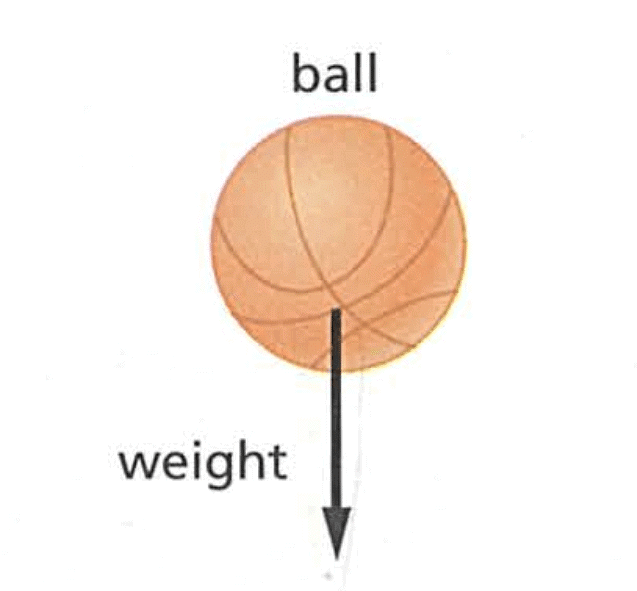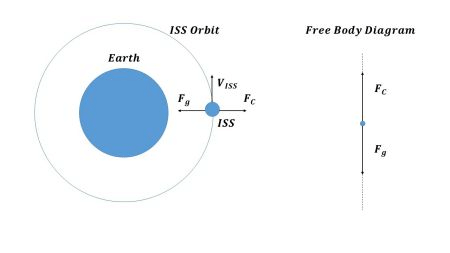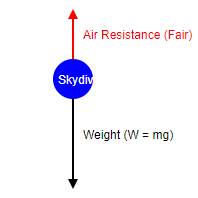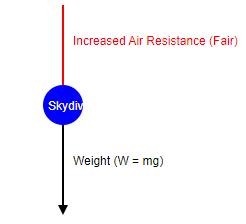Textbook Solution : Forces and their Effects | IGCSE Cambridge Science for Year 7 - Class 7 PDF Download
Gravity
Q1. The diagram in figure 7.2 shows the weight of a ball on Earth. Make a copy of this diagram and draw a new diagram to show the weight of the ball on the Moon. (The pull of the Moon’s gravity is about 1/6 of the gravity on Earth.)
Ans: To draw the new diagram, represent the weight of the ball on the Moon by shortening the arrow to one-sixth of its original length in the diagram, as Moon’s gravity is about 1/6th that of Earth’s gravity.

Q2. An astronaut is orbiting the Earth in a space station. Draw a diagram to show the force exerted by the Earth on the astronaut and on the space station. Include the Earth on your diagram. Label each arrow with the name of the force.
Ans: In the diagram, draw arrows from the space station and the astronaut towards Earth. These arrows should indicate the gravitational pull exerted by Earth. Label the arrows "gravitational force."

Q3. How much does each of the following weigh on Earth?
(a) a book with a mass of 2 kg
(b) a baby with a mass of 4 kg
(c) a man with a mass of 70 kg
(d) a car with a mass of 900 kg
Ans:
(a) 20 N (2 kg × 10 N/kg)
(b) 40 N (4 kg × 10 N/kg)
(c) 700 N (70 kg × 10 N/kg)
(d) 9000 N (900 kg × 10 N/kg)
Q4. On Earth, every kilogram of mass weighs 10 N. Use this information to work out the mass of each of these objects:
(a) a bag of apples that weighs 20 N
(b) a chair that weighs 60 N
(c) a bike that weighs 130 N
(d) a child that weighs 300 N
(e) a book that weighs 5 N
Ans:
(a) 2 kg (20 N ÷ 10 N/kg)
(b)6 kg (60 N ÷ 10 N/kg)
(c) 13 kg (130 N ÷ 10 N/kg)
(d) 30 kg (300 N ÷ 10 N/kg)
(e) 0.5 kg (5 N ÷ 10 N/kg)
Q5. Would the Sun create a larger or smaller force of gravity than the Moon on an orbiting spacecraft? Explain your answer.
Ans: The Sun would create a larger force of gravity on an orbiting spacecraft than the Moon. This is because the Sun’s mass is much greater than that of the Moon, and gravitational force increases with mass.
Q6. Mars has a gravitational field strength about 40% of the value on Earth.
(a) If you measured your mass on Mars, would it be less than, the same as, or more than your mass on Earth?
(b) The Earth’s gravitational field strength is 10 N/kg. What is the value of Mars's gravitational field strength?
(c) How much would a person of mass 50 kg weigh on Earth?
(d) How much would a person of mass 50 kg weigh on Mars?
Ans:
(a) The mass would be the same. Mass is a measure of the amount of matter and does not change with location.
(b) 4 N/kg (40% of 10 N/kg)
(c) 500 N (50 kg × 10 N/kg)
(d) 200 N (50 kg × 4 N/kg)
Q7.
(a) What is the size of the force with which the Earth pulls a 20 kg suitcase?
(b) What is the size of the force with which the 20 kg suitcase pulls on the Earth?
Ans:
(a) 200 N (20 kg × 10 N/kg)
(b) 200 N. According to Newton's third law of motion, the force with which the suitcase pulls back on the Earth is equal in magnitude and opposite in direction to the force with which the Earth pulls the suitcase.
Q8. Which is bigger, the force of gravitational attraction:
1. between you and an elephant
2.between an elephant and the Earth
3. between you and the Earth
Explain your answer.
Ans: 1. The force between an elephant and the Earth is the largest. This is because the Earth's mass is much larger than either your mass or the elephant's, and gravitational force is directly proportional to the mass of the objects involved.
Air Resistance
Q1. At the top of very high mountains, like Mount Everest, there are fewer air particles in each cubic metre of air than at lower altitudes. Would the air resistance to a moving object at the top of a high mountain be larger, smaller or the same as the air resistance to the same moving object at sea level?
Ans: The air resistance to a moving object at the top of a high mountain would be smaller than at sea level due to fewer air particles.
Q2. Use the idea of particles to explain why a parachute produces a larger force of air resistance than a skydiver's own body.
Ans: This is because the parachute has more surface.
Q3. Why can a feather and an apple fall at the same rate in a vacuum?
Ans: Because there is no air resistance.
Q4. What would happen to the motion of objects moving horizontally in a straight line if there was no friction or air resistance?
Ans: Objects would continue to move at a constant speed in a straight line indefinitely.
End of the Chapter Review
Q1. The newton is the correct unit for which one of these? Mass, Gravitational field strength, Weight
Ans: Gravitational field strength.
Q2. Fill in the missing word: On a force diagram the ____ of the arrow shows you how large the force is.
Ans: Length.
Q3. On Earth, how much does a mass of 4 kg weigh?
Ans: 4 * 9.8 = 39.2 Newtons.
Q4. If you travelled to the Moon what would change: your mass, your weight or both?
Ans: Your weight would change, but your mass would stay the same.
Q5. Which one of these formulae correctly links mass, weight and gravitational field strength?
Ans: Weight = mass x gravitational field strength.
Q6. Say whether each statement is true or false:
(a) Gravity can repel as well as attract.
Ans: False.
(b) The gravitational field strength of an object depends on the mass of the object.
Ans: True.
(c) Large masses attract smaller masses but small masses do not attract larger ones.
Ans: False.
(d) Air resistance slows down moving objects.
Ans: True.
(e) There is no air resistance in a vacuum.
Ans: True.
(f) There is no gravity in a vacuum.
Ans: False.
Q7. Which two forces act when a skydiver falls using a parachute?
Ans: Gravitational force and air resistance.
8. A skydiver, dropping very fast, opens his parachute just a few hundred metres before reaching the ground. Draw and label diagrams and use them to show the difference between the forces that act:
(a) just before the parachute opens.
(b) when the parachute has just opened.
Ans (a) 
Before the parachute opens, the skydiver is falling at terminal velocity, so the weight force (gravity) is balanced by the air resistance.
Ans (b)
Just after the parachute opens, the air resistance greatly increases, creating a net upward force that slows the skydiver's descent.
Q9. Astronauts on a space mission travel from the Earth to the Moon. Describe the directions of the main gravitational forces they experience:
(a) close to the Earth
(b) halfway between Earth and the Moon
(c) when orbiting the Moon
(d) when they have landed on the Moon.
Ans:
(a) Toward Earth.
(b) Both Earth and Moon, stronger from the closer body.
(c) Toward the Moon.
(d) Toward the Moon.
Q10.
(a) Why should parachutes have a large surface area?
(b) Why would it not be safe for an adult to use a parachute that had been designed for a small child?
(c) Can parachutes work in a vacuum? Explain your answer.
Ans:
(a) To increase air resistance and slow down descent.
(b) It would not provide enough air resistance to slow the descent safely.
(c) No, because there is no air to create resistance.
Q11. Celi has a mass of 50 kg. Gravitational field strength on Earth is 10 N/kg.
(a) What is Celi's weight on Earth?
Ans: 50 * 10 = 500 Newtons.
(b) Gravitational field strength on the Moon is about 1.5 N/kg.
(i) What would Celi's mass be on the Moon?
Ans: The same, 50 kg.
(ii) How much would Celi weigh on the Moon?
Ans: 50 * 1.5 = 75 Newtons.
Q12. Why do astronauts in a space station orbiting the Earth appear weightless even though they are still pulled by the Earth's gravity?
Ans: Astronauts appear weightless in a space station orbiting the Earth because both they and the space station are in a state of free fall towards the Earth, moving along a curved path that keeps them in orbit. The absence of a supporting force under their feet (like the ground on Earth) results in the sensation of weightlessness.
Q13. The gravitational field strength at the top of a very high mountain is less than it is at sea level. Use this fact to suggest why air resistance at the top of a very high mountain is usually less than it is at sea level.
Ans: Fewer air particles at high altitudes lead to less air resistance.
|
32 videos|61 docs|22 tests
|
FAQs on Textbook Solution : Forces and their Effects - IGCSE Cambridge Science for Year 7 - Class 7
| 1. How does gravity affect objects on Earth? |  |
| 2. How does air resistance impact the motion of objects? |  |
| 3. What is the relationship between gravity and air resistance? |  |
| 4. How do forces like gravity and air resistance affect sports and other physical activities? |  |
| 5. How can we minimize the effects of air resistance in certain activities or objects? |  |





















